| Aug 03, 2020 | |
Moth eye inspires self-cleaning, anti-icing, antireflection, and self-healing coating(Nanowerk News) Back in 2011, researchers at Harvard School of Engineering and Applied Sciences (SEAS) pioneered a bioinspired glass coating called Slippery Liquid-Infused Porous Surfaces (SLIPS) – the slipperiest synthetic surface known. |
|
| However, SLIPS coating have several drawbacks including volatilization and leakage of lubricant caused by long-term usage. | |
| In a new study reported in ACS Nano("Moth-Eye Mimicking Solid Slippery Glass Surface with Icephobicity, Transparency, and Self-Healing"), researchers in South Korea demonstrate a facile, icephobic, highly transparent, and self-healable solid slippery surface to overcome the mentioned drawbacks using a combination of the biomimetic nanopillar structure (moth-eye structure) and the biomimetic solid lubricant (paraffin wax). | |
| The team shows that moth-eye mimicking nanopillar structures serve as an alternative for the porous SLIPS structure, and they enable the surface to have a high transparency based on the antireflective effect. | |
| Paraffin wax has intrinsic water repellency and low thermal conductivity and coats the moth-eye structures as a solid lubricant to repel the water droplets and provide damage recovery. | |
| The integrated morphology of moth-eye structures and the slight embedding of a suspended paraffin coating layer traps the air and presents icephobicity. | |
| As show in the figure below, the team prepared the moth-eye mimicking solid slippery surfaces using a two-step process involving nanostructuring and paraffin coating. | |
 |
|
| (a) Fabrication schematic diagram, (b) SEM image of PS beads coated on quartz glass surface after the size-reduction process. (Reprinted with permission by American Chemical Society) | |
| The researcher coated transparent glass with variations of their biomimetic solid slippery surface with various nanopillar heights and paraffin coating thicknesses. They then investigated their effect on water droplet freezing time and adhesion strength, as well as the antireflection and self-healing properties. | |
| They found that the air volume between the nanostructures is critical for delaying icing time and for improved deicing performance with a low adhesion strength of the ice droplet on the surface. The low thermal conductivity of paraffin also aids the icephobicity, but paraffin thickness has little influence on the icing delay and deicing performance. While the paraffin coating layer degrades the transmittance of glass, the moth-eye nanostructures improve the transmittance with the antireflective effect. | |
| When the mechanical scratch of the paraffin layer deteriorates the hydrophobicity of the surface, a simple AM 1.5 G sunlight treatment for 5 minutes recovers the hydrophobicity of the damaged biomimetic slippery surface. Moreover, the repeated mechanical damage and healing process results in superhydrophobicity by making nanomorphology with broken nanopillars and conformal paraffin coating on the broken nanopillars. | |
| The optical property is also maintained without a significant decrease after self-healing. | |
| The team also applied this biomimetic solid slippery surface for solar cell cover-glass to confirm the possibility of practical application. |
 By
Michael
Berger
– Michael is author of three books by the Royal Society of Chemistry:
Nano-Society: Pushing the Boundaries of Technology,
Nanotechnology: The Future is Tiny, and
Nanoengineering: The Skills and Tools Making Technology Invisible
Copyright ©
Nanowerk LLC
By
Michael
Berger
– Michael is author of three books by the Royal Society of Chemistry:
Nano-Society: Pushing the Boundaries of Technology,
Nanotechnology: The Future is Tiny, and
Nanoengineering: The Skills and Tools Making Technology Invisible
Copyright ©
Nanowerk LLC
|
|
|
Subscribe to a free copy of one of our daily Nanowerk Newsletter Email Digests with a compilation of all of the day's news. |
